The NZXT Kraken Z63 & X73 AIO Cooler Review: Shiny On Top, Solid Underneath
by E. Fylladitakis on August 19, 2020 11:00 AM ESTTesting Results, Maximum Fan Speed
Our maximum speed testing is performed with both the fans and the pump of the kit powered via a 12V DC source. This input voltage should have the pump and fans matching the speed ratings of the manufacturer. NZXT states that the 120 mm fans of the X73 have a rotational speed of 2000±300 RPM and the 140 mm fans of the Z63 a speed of 1800±300 RPM. What really stands out from these specifications is the very high-speed tolerance – a >15% tolerance definitely is not common amongst quality products. According to our tachometer, the 120 mm and 140 mm fans were rotating at about 1870 RPM and 2120 RPM respectively, well within their rated specifications. There were some speed differences between identical fans but these did not exceed 100 RPM, which is a little high but not dramatic.

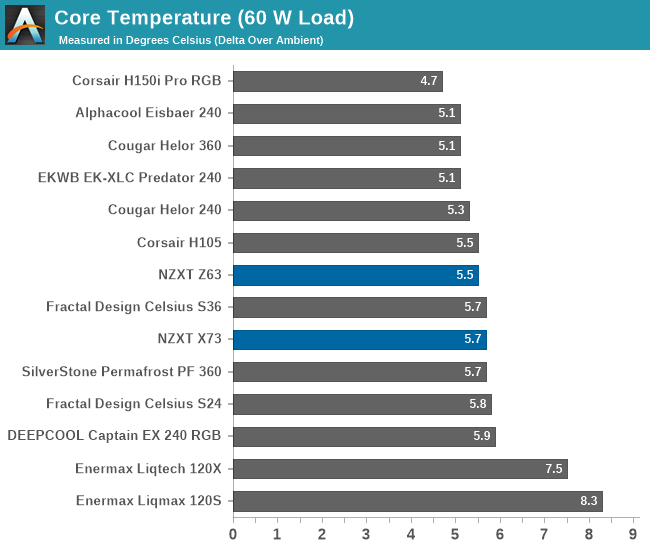
| Core Temperature, Constant Thermal Load (Max Fan Speed) |
The NZXT X73 stands out in our charts, as it manages to overtake every other similarly-sized AIO cooler that we have tested to this date. It has an average thermal resistance of 0.0719 °C/W, which is very good, but that comes with a sound pressure level of 42.9 dB(A), a figure that is definitely on the high side when compared to other, similar solutions. Although the X73 seems to be falling slightly behind when the thermal load is low, it is very efficient when having to cope with high loads, making it one of the best AIO coolers for handling large thermal loads.
Meanwhile the Z63, despite the use of 140 mm fans, falls behind in terms of cooling performance. With an average thermal resistance of 0.0751 °C/W, the Z63 performs well enough, but its thermal performance is fairly close to other coolers with smaller 240 mm radiators; so the Z63's extra size doesn't seem to be helping it much. Past this, like the X73, the Z63 does not stand out when the thermal load is low, but it is significantly more efficient when the thermal load is very high.
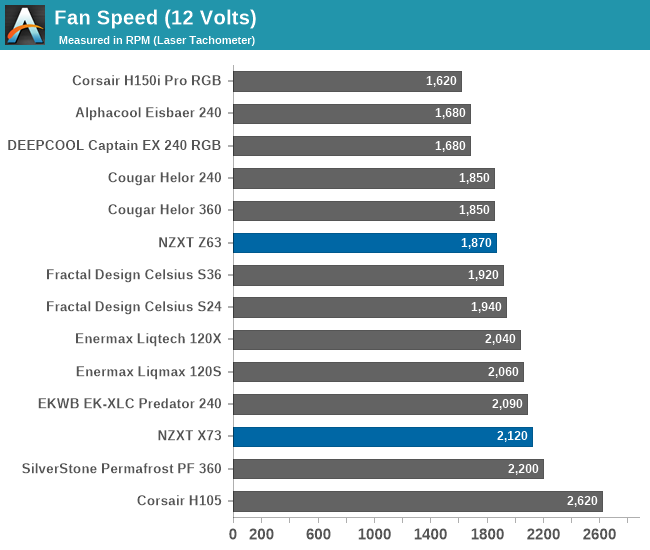
The Z63 does come with one upside, however: with a sound pressure level of 39.8 dB(A), noise levels are notably lower than those from the X73.
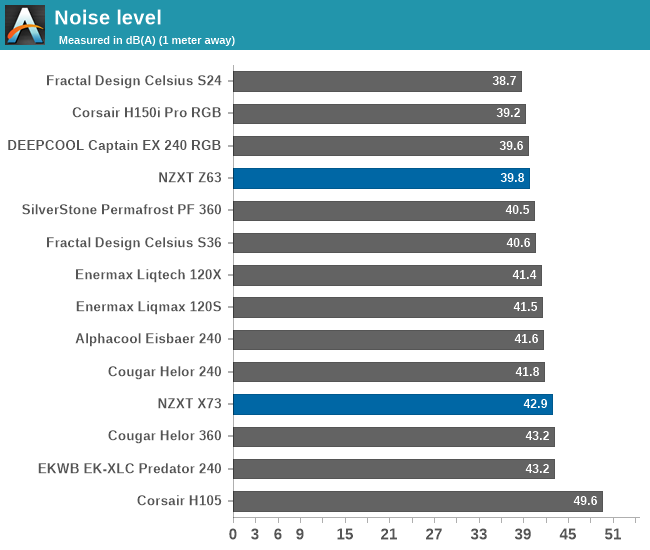
Testing Results, Low Fan Speed
Using a PWM voltage regulator, we reduced the speed of the fans manually down to half their rated speed. At this setting, the 120 mm fans of the X73 and the 140 mm fans of the Z63 rotate at 1240 RPM and 1050 RPM respectively. The pumps were also connected on the same power source, functioning properly at this low speed setting.

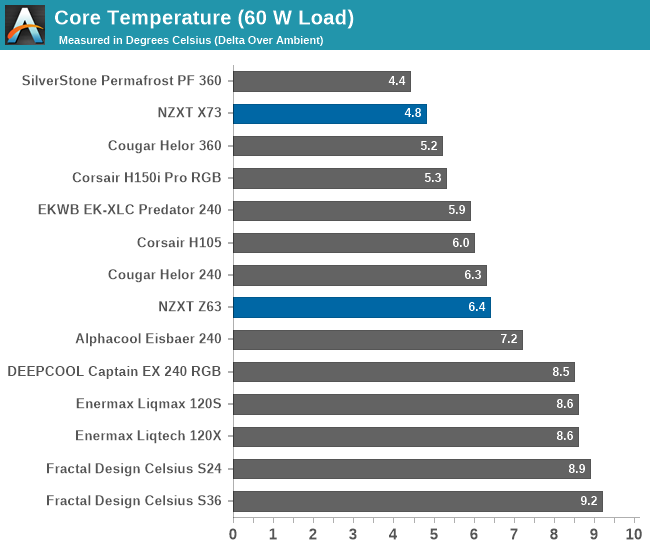
| Core Temperature, Constant Thermal Load (Low Fan Speed) |
NZXT’s X73 once again stands out with an average thermal resistance of 0.0812 °C/W, the best average figure that we have recorded from any AIO cooler to this date. The thermal resistance of the X73 is virtually stable regardless of the load with its pump and fans operating in this state, surpassing most other AIO coolers in any scenario.
However when we check our sound level meter, we measure a sound pressure of 37.4 dB(A), a relatively high figure compared to other coolers. That is mostly because of the high speed and high static pressure nature of the fans, which creates aerodynamic noise. That said, the cooler can certainly operate at lower noise levels if connected to a dynamic control system, such as any modern motherboard that would allow full control over the speed of its fans and pump, but at the obvious expense of thermal performance.
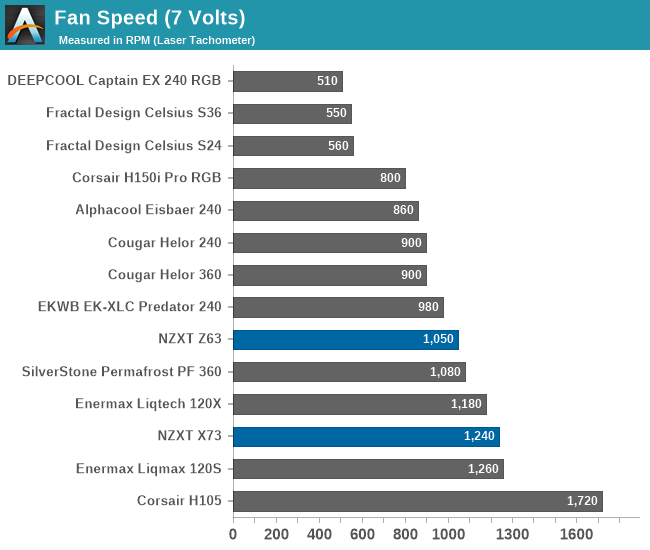
The NZXT Z63 also performs well in our low-speed testing. With an average thermal resistance of 0.0935 °C/W, the 280 mm cooler manages to get dangerously close to many larger AIO coolers, and even surpasses a few of them. Although the mediocre results we got from low load testing initially misguided us into believing that the Z63 will fall far behind the competition, it proved to be very efficient at handling heavy loads. Meanwhile the 35.1 dB(A) of noise coming from the cooler should be tolerable for the majority of home PC users.
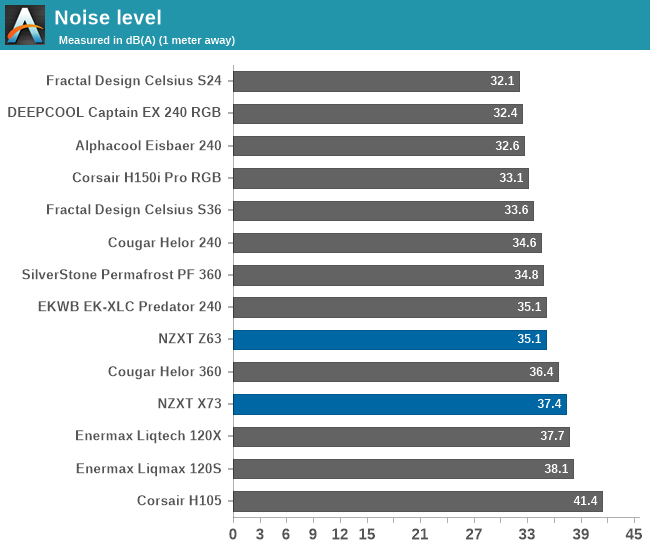
Thermal Resistance VS Sound Pressure Level
During our thermal resistance vs. sound pressure level test, we maintain a steady 100W thermal load and assess the overall performance of the coolers by taking multiple temperature and sound pressure level readings within the operating range of the stock cooling fans. The result is a graph that depicts the absolute thermal resistance of the cooler in comparison to the noise generated. For both the sound pressure level and absolute thermal resistance readings, lower figures are better.
This graph reveals very interesting information. We can see that the NZXT X73 surpasses the absolute thermal resistance of all other 360 mm radiator coolers and also is quieter than Cougar’s Helor and the older Celsius S36. But it is slightly louder than the PF 360 at any given level of thermal performance.
More interesting, perhaps, is the NZXT Z63. It may trail the thermal resistance of the X73 by a small margin, but it manages the same level of thermal performance with significantly less noise. The thermal resistance to sound pressure level curve is steep and suggests that the Z63 can, at the expense of higher noise levels, even outperform the 360 mm coolers if paired with more powerful 140 mm fans.


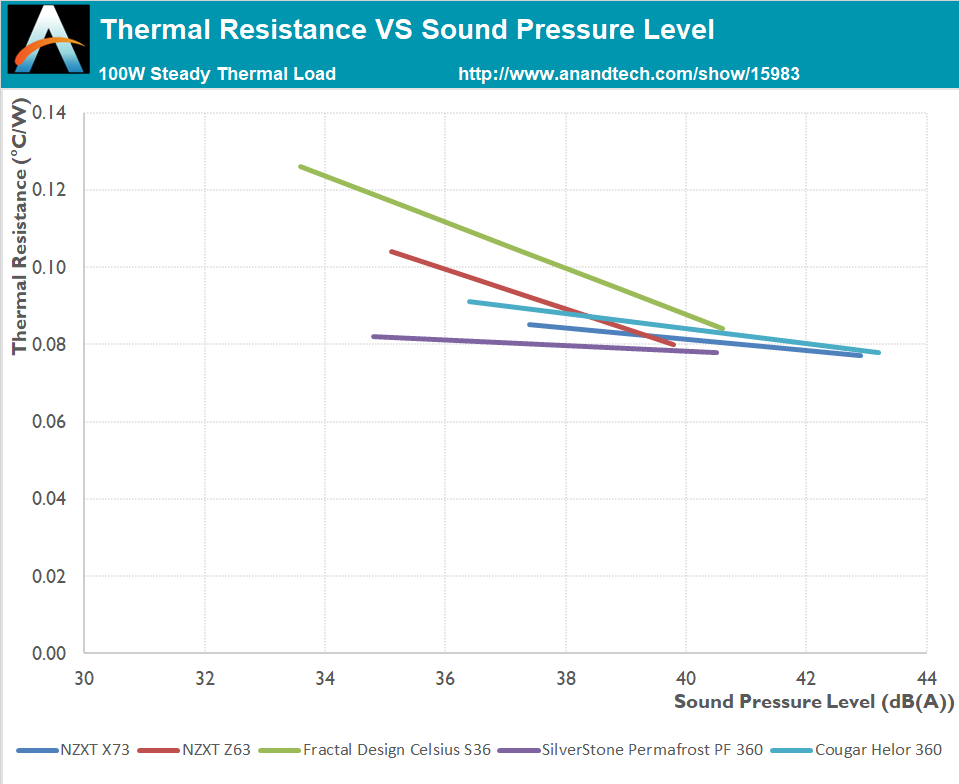








61 Comments
View All Comments
QB - Thursday, August 20, 2020 - link
I ran my H80i for close to 8 years (not sure the exact date, but it was at least 7 for sure) and only retired it this year for an iCUE H110i RGB PRO XT. Not a single leak, and it only suffered from a minor amount of liquid permeation... If I was to guess how much liquid disappeared over the 7+ years based only on the sound of the liquid moving around the radiator, I would say it was maybe 25%. I did not "need" to retire it, but with all new gear sitting under it, I figured an all new cooler was also warranted :)QB
silencer12 - Thursday, August 20, 2020 - link
Repeat after me. You will eventually be using liquid cooling since air cooling will not be able to keep up in the future because processors will generate much more heat.Guspaz - Thursday, August 20, 2020 - link
Air cooling can handle a fully loaded 280W threadripper without trouble. Consumer chips are still at 105W. I think we’re good for a while yet. Liquid cooling does not substantially outperform air cooling until you go larger than 240mm rads, where space can become a concern.Luminar - Thursday, August 20, 2020 - link
Future processors will generate much more heat?Are you talking about Intel's processors in 2022 (if Intel still even exists)?
Unashamed_unoriginal_username_x86 - Thursday, August 20, 2020 - link
Intel isn't going to up and disappear because they lost the DIY segment, it has 10x the revenue of AMD, and a lot of market share for AMD to bite into still.Speaking of the DIY market, it's very popular to overclock there, and the biggest bottleneck outside of if it's unlocked is thermal management.
silencer12 - Thursday, August 20, 2020 - link
Yes, future processors will generate more heat. Likely, in my opinion. I am talking more than 2-4 years in the future.Intel made 71.9 billion (2019). Of course they will exist. They are coming out with their own graphics cards.
@unshamed explained the rest already for me below on market share.
PeachNCream - Friday, August 21, 2020 - link
I don't think you will see widespread need for water cooling in desktop PC hardware in the near future. Not when the average desktop CPU currently sits between 35-65W TDP with a few halo models reaching to +95W. Compute resources have to meet other targets besides more instructions per second in order to be economically viable products. That, of course, dismisses enterprise workloads in data centers where I think liquid cooling might be a more reasonable consideration and where packing as much density into a given rack while having the staffing and vendor support to handle potential liquid cooling is a fair bit more doable.silencer12 - Friday, August 21, 2020 - link
Acknowledged.Tom Sunday - Thursday, October 8, 2020 - link
I just purchased my all new prebuild PC from my local 'strip-center' tech-shop for $800 cash including a used RTX 1080 ($95) from a cryptocurrency miner since the mining days are now virtually a thing of the past. Yes...Intel has a lot of cash and more even today after just spinning off one off their subsidiaries. NVIDIA just paid $40 billion for ARM. Making CPU's? Corsair went public and looking at their "S1-document filing" made Mr. Paul (CEO) a cool $100 million with stock options. My Reality: The boys at the computers show were laughing that some highly touted AIO's now costing more then brand new older generation CPU's.They said that AIO water-cooler purchases applies to less than 20% of all customers or people coming to the show. Furthermore that the total USA motherboard market represents up to 90% of solely 'mainstream boards' between $90-$125 and which generally do not overclock. Madnu said..."For the man on the street cash is tight." I am not good with numbers and marketing and many other things so what do I know? But listening to the 'geek-team' from Bangladesh I inherently know something is not right with the hardware prices as touted on the open market. Paying $280 for a AIO? Meanwhile I am back in my basement command center listening to the Mugen-5 humming along. Playing Fallout 4 for the very first time in 'Max' settings. Today Mom is baking a strawberry pie. Life is good.Beaver M. - Friday, August 21, 2020 - link
Judged by what?AMD, whos CPUs always were running hotter/less efficient than Intel at the same manufacturing process?
Intel, who is still stuck with hot-headed 14 nm CPUs?
Dont make me laugh. Telling the future by the unique situations we have now, is pretty nonsensical.
Even in 10 year, its more likely that manufacturers will optimize their case ventilation and/or space for air coolers.
I mean, most midi cases have space for 4 to 6 more D15-size air coolers, that isnt used at all.
Its long due time for a new standard anyway. ATX is 25 years old!
And before I put some crappy AIO in my case, I rather build a water cooler myself for a few hundred bucks more.